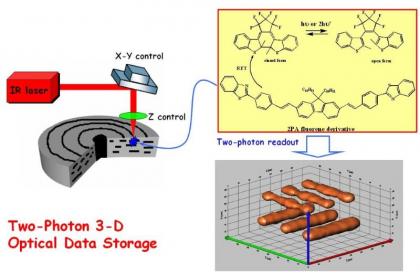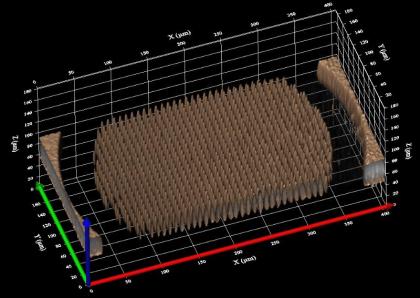High-Density Optical Storage
Photonic Materials Research at NJIT
One of the areas of our materials research focus entails the fabrication of high-density data recording disks. These next-generation DVD-type storage disks can hold unprecedented volumes of data. Dr. Kevin D. Belfield's molecular electronics research group, with funding from the National Science Foundation, are investigating these new materials.
How are the high-density storage disks different from conventional storage disks? The high-density disks encode, manipulate, and retrieve information at the molecular level, as opposed to current semiconductor techniques, which rely on miniaturization of bulk devices such as integrated circuits.
When will these disks reach the market? Two US patent applications have been granted on the technology and others are pending, which could pave the way for next generation, ultra high-density optical data storage for tomorrow's computational needs.
 |
 |
Figure 1. A schematic illustration of the two-photon 3D optical data storage system
Description:
A two-photon 3D optical data storage system consisting of a bichromophoric mixture of diarylethene and fluorene derivative as the storage medium is demonstrated here. Binary information bits were recorded throughout all three dimensions of the storage medium by two-photon localized excitation on the diarylethene molecules, transforming the closed form of diarylethene into the open form. The readout method is based on the modulation of the two-photon fluorescence emission of fluorene by the closed form of diarylethene.

Figure 2. Two-photon 3D readout of the recorded data
Description:
This 3D image was reconstructed using 3D constructor (Ver. 5.1, MediaCybernetics Inc.) from successively two-photon fluorescence imaging (readout) of 33 XY data planes along the axial direction (1 micron distance between each image). The principle for this novel two-photon 3D optical storage device was based on a bichromophoric mixture consisting of diaryletheneand fluorene derivative, suitable for recording data in thick storage media. The open and closed forms of diarylethene codify the binary information. The read-out method is based on the modulation of the two-photon fluorescence emission of fluorene by the closed form of diarylethene.
Selected publications:
-
Ghazvini Zadeh, E. H.; Bondar, M. V.; Mikhailov, I. A.; Belfield, K. D. “Linear Photophysics, Stimulated Emission and Ultrafast Spectroscopy of New Two-Photon Absorbing Diketopyrrolopyrrole Derivatives” Journal of Physical Chemistry C 2015, 119, 8864-8875.
-
Ghazvini Zadeh, E. H.; Woodward, A. W.; Richardson, D.; Bondar, M. V.; Belfield, K. D. “Stimuli-Responsive Cyclopenta[ef]heptalenes: Synthesis and Optical Properties” European Journal of Organic Chemistry 2015, 2271-2276.
-
Ali, M.; Kim, B; Belfield, K. D.; Norman, D.; Brennan, M.; Ali, G. S. “Inhibition of Phytophthora parasitica and P. capsici by Silver Nanoparticles Synthesized using Aqueous Extract of Artemisia absinthium” Phytopathology 2015, 105, in press.
-
Belfield, K. D.; Bondar, M. V.; Morales, A. R.; Frazer, A. F.; Mikhailov, I.; Przhonska, O. V. “Photophysical Properties and Ultrafast Excited State Dynamics of a New Two-Photon Absorbing Thiopyranyl Probe” Journal of Physical Chemistry C 2013, 117, 11941-11952.
-
Belfield, K. D.; Bondar, M. V.; Morales, A. R.; Yue, X.; Luchita, G.; Przhonska, O. V.; Kachkovsky, O. D. “Two-Photon Absorption and Time-Resolved Stimulated Emission Depletion Spectroscopy of a New Fluorenyl Derivative” ChemPhysChem 2012, 13, 3481-3491.
-
Belfield, K. D.; Bondar, M. V.; Morales, A. R.; Yue, X.; Luchita, G.; Przhonska, O. V. “Transient Excited-state Absorption and Gain Spectroscopy of a Two-Photon Absorbing Probe with Efficient Superfluorescent Properties” Journal of Physical Chemistry C 2012, 116, 11261-11271.
-
Luchita, G.; Bondar. M. V.; Yao, S.; Mikhaylov, I. A.; Yanez, C. O.; Przhonska, O. V.; Masunov, A. E.; Belfield, K. D. “Efficient Photochromic Transformation of a New Fluorenyl Diarylethene: One- and Two-photon Absorption Spectroscopy” ACS Applied Materials and Interfaces 2011, 3, 3559-3567.
-
Belfield, K. D.; Bondar, M. V.; Morales, A. R.; Padhila, L. A.; Przhonska, O. V.; Wang, X. “Two-photon STED Spectral Determination for a New V-shaped Organic Fluorescent Probe with Efficient Two-photon Absorption” ChemPhysChem 2011, 12, 2755-2762.
-
Yanez, C. O.; Andrade, C. D.; Yao, S.; Luchita, G.; Bondar, M. V.; Belfield, K. D. “Photosensitive Polymeric Materials for Two-Photon 3D Optical Data Storage Systems” ACS Applied Materials & Interfaces 2009, 1, 2219-2229. DOI: 10.1021/am900587u
-
Belfield, K. D.; Bondar, M. V.; Yanez, C. O.; Hernandez, F. E.; Przhonska, O. V. “One- and Two-photon Stimulated Emission Depletion of a Sulfonyl-containing Fluorene Derivative” Journal of Physical Chemistry B 2009, 113, 7101-7106. http://pubs.acs.org/doi/full/10.1021/jp902060m
-
Yanez C. O.; Andrade, C. D.; Belfield, K. D. “Characterization of Novel Sulfonium Photoacid Generators and their Microwave-assisted Synthesis” Chemical Communications 2009, 827-829. http://dx.doi.org/10.1039/b815831b
-
Mikhailov, I.; Belfield, K. D.; Masunov, A. E. “DFT-Based Methods in the Design of Two-Photon Operated Molecular Switches” Journal of Physical Chemistry A 2009, 113, 7080-7089.
-
Patel, P. D.; Mikhailov, I. A.; Belfield, K. D.; Masunov, A. E. “Theoretical Study of Photochromic Compounds: 2. Thermal Mechanism for Byproduct Formation and Fatigue-Resistance of Diarylethenes used as Data Storage Materials” International Journal of Quantum Chemistry 2009, 109, 3711-3722.
-
Corredor, C. C.; Huang, Z.-L.; Belfield, K. D.; Morales, A. R.; Bondar, M. V. “Photochromic Polymer Composites for Two-Photon 3D Optical Data Storage” Chemistry of Materials 2007, 19, 5165-5173. http://dx.doi.org/10.1021/cm071336b
-
Corredor, C. C.; Huang, Z. L.; Belfield, K. D. "Two-Photon 3-D Optical Data Storage via Fluorescence Modulation of an Efficient Fluorene Dye by a Photochromic Diarylethene". Advanced Materials, 2006, 18, 2910-2914. [This work has been highlighted by Nature Photonics].
-
[2] Corredor, C. C.; Belfield, K. D.; Bondar, M. V.; Przhonska, O. V.; Hernandez, F. E.; Kachkovsky, O. D. One and Two-Photon Photochromism of 3,4-Bis-(2,4,5-trimethyl-thiophen-3-yl)furan-2,5-dione€?. Journal of Photochemistry and Photobiology A: Chemistry, 2006, 184, 177-183.
-
Belfield, K. D.; Bondar, M. V.; Corredor, C. C.; Hernandez, F. E.; Przhonska, O. V.; Yao, S. Two-photon photochromism of a diarylethene derivative enhanced by resonance energy transfer from two-photon absorbing fluorenese?. ChemPhysChem., 2006, 7, in press.
-
Belfield, K. D.; Schafer, K. J. "A New Photosensitive Polymeric Material for Optical Data Storage using Multichannel Two-Photon Fluorescence Readout". Chemistry of Materials, 2002, 14, 3656-3662.
-
Belfield, K. D.; Liu, Y.; Negres, R. A.; Fan, M.; Pan, G.; Hagan, D. J.; Hernandez, F. E.; "Two-photon photochromism of an organic material for holographic recording". Chemistry of Materials, 2002, 14, 3663-3667.
-
Belfield, K. D.; Ren, X.; Hagan, D. J.; Van Stryland, E. W.; Dubikovsky, V.; Miesak, E. J. "Near-IR Two-Photon Photoinitiated Polymerization Using a Fluorone/Amine Initiating System". Journal of the American Chemical Society, 2000, 122, 1217-1218.
